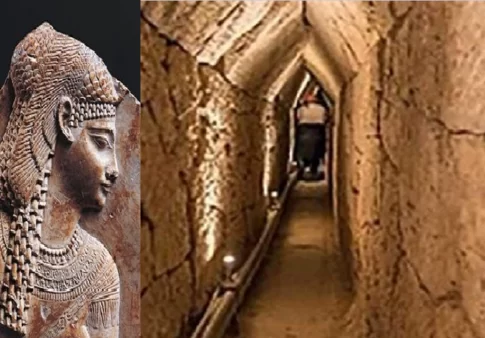A remarkable archaeological discovery beneath the ancient ruins of Taposiris Magna on Egypt’s northern coast is reigniting global fascination with one of antiquity’s most iconic figures: Cleopatra VII. In a dramatic development that has captured the attention of historians and archaeologists worldwide, a team led by Dominican archaeologist Dr. Kathleen Martinez has uncovered a sprawling tunnel beneath the temple complex, a discovery many now believe could hold the key to Cleopatra’s long-lost tomb.
Described by Egypt’s Ministry of Tourism and Antiquities as a “geometric miracle,” the newly found tunnel stretches over 1,300 meters (4,281 feet) and lies 13 meters beneath ground level, cut with astonishing precision through solid sandstone. According to the Ministry’s statement, parts of the tunnel are submerged, raising further questions about its purpose and what still lies hidden below.
“This is no ordinary architectural feature,” said Dr. Zahi Hawass, Egypt’s former Minister of Antiquities “The level of engineering sophistication resembles classical feats like the Tunnel of Eupalinos in Samos. But here, it could be tied to one of the greatest enigmas of the ancient world — Cleopatra’s final resting place.”
Located near modern-day Alexandria, Taposiris Magna was founded in the 3rd century BCE by Ptolemy II and is believed to have been dedicated to Osiris and Isis, the Egyptian deities closely associated with the royal line and particularly revered by Cleopatra herself.
Dr. Martinez, who has spent nearly two decades excavating the site under a special permit from the Egyptian government, has long theorized that Cleopatra and her Roman consort Mark Antony may have been buried there. The hypothesis challenges more traditional assumptions that her tomb lies in Alexandria, a city much of which now rests beneath the Mediterranean.
Dr. Martinez said, “We’ve found Greco-Roman burials, coins bearing Cleopatra’s face, statues of Isis, and now a tunnel that may have served a hidden or sacred function. Everything points to this being more than just a ceremonial temple. It may have been a royal burial site, hidden to protect its occupants for eternity.”
Taposiris Magna’s coastal location adds layers of mystery. Seismic activity over the centuries, most notably between 320 and 1303 CE, has caused portions of the temple complex to collapse and sink beneath the Mediterranean. This reality has prompted archaeologists to launch marine excavations around the site, particularly where tunnels may extend from Lake Mariout to the sea.
Preliminary underwater surveys by Egypt’s Department of Underwater Antiquities and foreign partners have revealed submerged chambers and collapsed temple sections — suggesting the full extent of Cleopatra’s complex might lie underwater.
“If the burial site was built in a sacred alignment between the temple and the sea, then it’s possible the tomb is underwater,” said Dr. Salima Ikram, a professor of Egyptology at The American University in Cairo. “Given the waterlogged portions of the tunnel already found, underwater archaeology is no longer speculative—it’s essential.”
“This excavation at Taposiris Magna combines world-class science, deep historical relevance, and public imagination,” said Dr. Mostafa Waziri, Secretary-General of the Supreme Council of Antiquities. “It’s the kind of find that reminds the world that Egypt still holds many secrets.”
Excavations are ongoing and will likely intensify over the coming months to map the tunnel’s full extent and identify any hidden chambers.
As the waters and sands slowly yield their secrets, the world may be closer than ever to solving a mystery that has endured for over two millennia.
Could Cleopatra queen, strategist, lover, and legend — finally be found?


